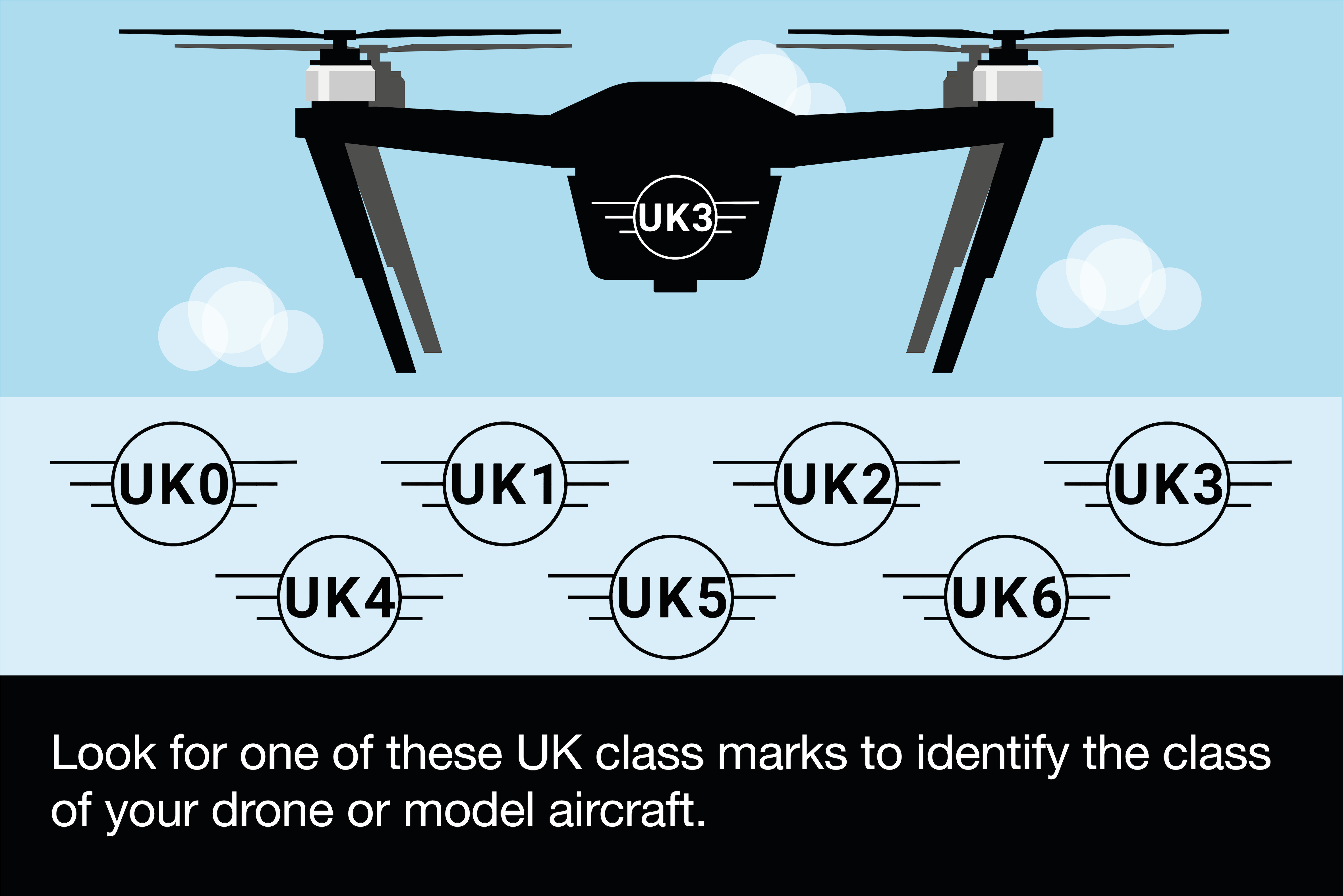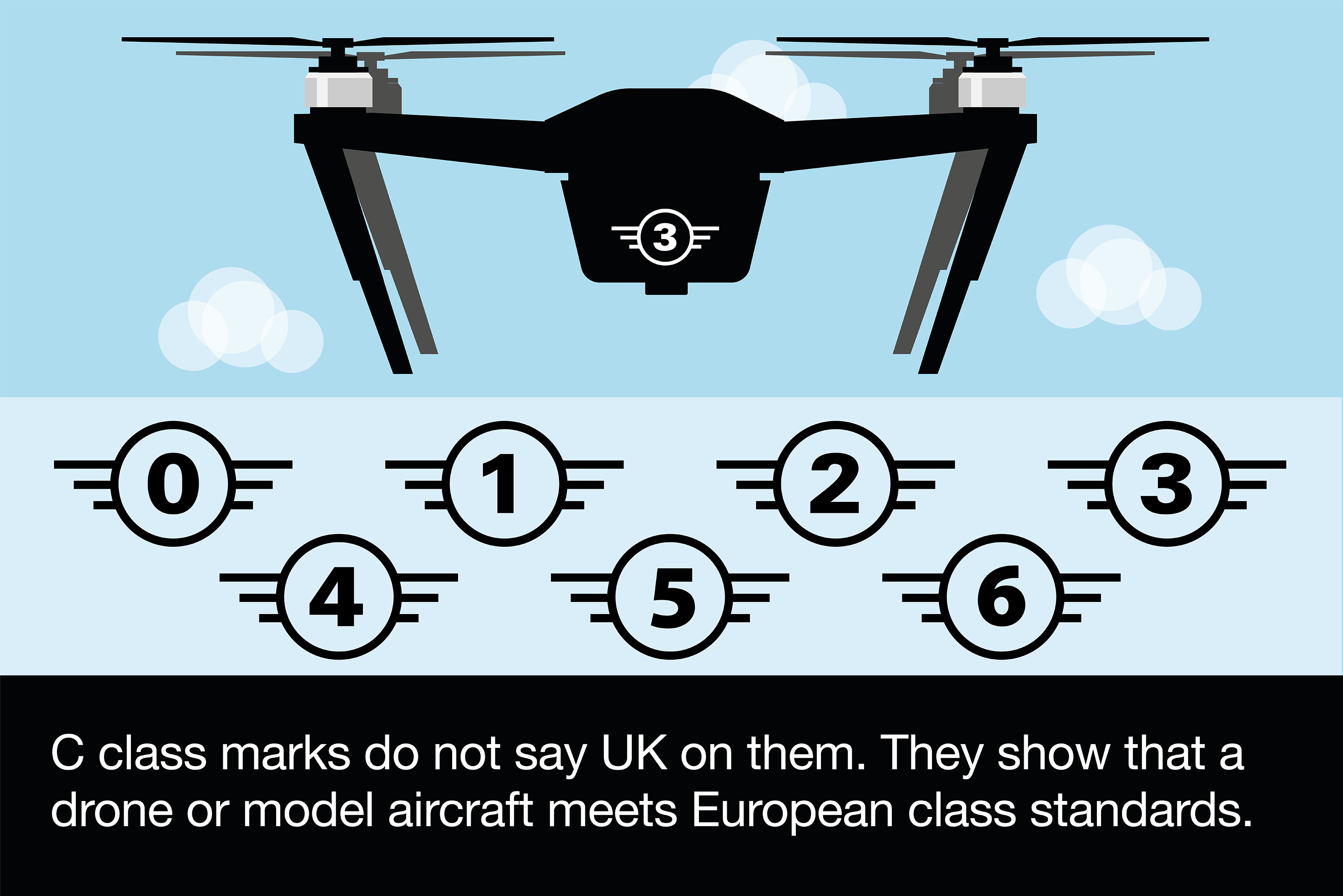ID and registration requirements
There are two IDs you may need before flying drones or model aircraft outdoors in the UK:
- Flyer ID, which shows you’ve passed the basic competence test
- Operator ID, which must be labelled on your drone or model aircraft
You may need to have both.

Type of ID needed
The IDs you need depend on the weight of your drone or model aircraft and whether it has a camera.
You must get a Flyer ID if you want to fly a drone or model aircraft that weighs 100g or above.
You must get an Operator ID if you own or are responsible for a drone or model aircraft that:
- weighs 250g or above
- weighs 100g or above and has a camera
You don’t need a Flyer ID or Operator ID to fly a drone or model aircraft that weighs less than 100g.
Remember, even if you do not need to register, you must still follow the applicable rules summarised in this Drone and Model Aircraft Code when you fly.
Registration requirements
| Weight of drone or model aircraft | Class | Flyer ID | Operator ID |
| 250g to less than 25kg | UK1, UK2, UK3, UK4 | Required | Required |
| 100g to less than 250g; with a camera |
UK0 with a camera | Required | Required |
| 100g to less than 250g; without a camera |
UK0 without a camera | Required | Optional |
| Less than 100g | Not applicable | Recommended | Optional |
Regulations until 1 January 2026
The regulations for the types of ID needed are different for the short period until 1 January 2026.
We've set out the regulations that apply before 1 January 2026 in this section. However, we recommend following the new regulations to make sure you're ready to fly safely and legally from 1 January 2026 onwards.
Flyer ID
Until 1 January 2026, you must get a Flyer ID if you want to fly a drone or model aircraft that weighs 250g or above.
Operator ID
Until 1 January 2026, you must get an Operator ID if you own or are responsible for a drone or model aircraft that:
- weighs 250g or above
- weighs up to 250g if it has a camera (unless it's a toy).
Class marks
While legacy drone or model aircraft models can continue to be sold, any new models placed on the market from 1 January 2026 must have a UK class mark, from UK0 class to UK6 class.
If you bought your drone or model aircraft before 1 January 2026, it’s unlikely to have a UK class mark. You can still fly your drone or model aircraft by following the rules in this Drone Code that apply to you based on the weight of your aircraft.

If your drone or model aircraft has a C class mark on it, the manufacturer has declared that it meets the European class standards. You can fly a C class drone as if it is the corresponding UK class drone until 31 December 2027. For example, you can fly a C1 class drone as if it is a UK1 class drone.

This Drone Code does not cover flying C5/UK5 or C6/UK6 class drones. You must get authorisation from the CAA if you want to do more advanced flying (opens in a new tab).
Flyer ID
You must pass the CAA’s official theory test to get a Flyer ID before flying a drone or model aircraft covered by the regulations. We recommend carrying a copy of your Flyer ID whenever you fly.
You’re responsible for flying safely and legally whenever you fly.
Operator ID
The operator is the person responsible for managing a drone or model aircraft. This means they’re responsible for things like maintaining it and ensuring any remote pilot who flies it holds the necessary level of competence.
You must be 18 or over to get an Operator ID.
The operator is usually the person or organisation that owns the drone or model aircraft, but not always. For example, if you’re younger than 18 and you own a drone or model aircraft, you must ask your parent or guardian to register for an Operator ID. You’ll still be able to fly as long as you have a Flyer ID.
Categories of drone and model aircraft operations
The types of flying you do with your drone or model aircraft are known as operations.
There are different categories of operations. The categories affect things like where you can fly, and how close to people and crowds you can fly.
| Category | Type of flying |
| Open Category | Low-risk, simple flying |
| Specific Category | Moderate-risk, complex flying |
| Certified Category | High-risk, complex flying |
Flying in the Open category
The Open Category has three sub-categories.
Each sub-category sets out the weight or class of drone or model aircraft you can fly and the distance you must keep from people.
Open sub-category requirements and distances
| Sub-category | Weight or class of drone or model aircraft you can fly | Distance from people and places |
| Over People (A1) |
Less than 250g or C0 or UK0 or UK1 class. From 1 January 2026 until 31 December 2027, you can also fly a C1 class drone or model aircraft. |
You can fly closer to people than 50m, including people who are not involved in what you’re doing. You can fly over people, including people who are not involved in what you’re doing. |
| Near People (A2) |
UK2 class. Until 31 December 2027, you can also fly a C2 class drone or model aircraft.
Less than 2kg and not UK2 or C2 class. |
You must not fly within 30m of people unless they’re involved in what you are doing, or you fly in low speed mode. If you fly in low speed mode, you can reduce this distance to 5m from people. You must not fly over people who are not involved in what you're doing. You must not fly within 50m of uninvolved people. You must not fly over people who are not involved in what you're doing. |
| Far from People (A3) |
UK2, UK3 or UK4 class. UAS that is privately built and less than 25kg. UAS that was placed on the market before 1 January 2026 and less than 25kg. Until 31 December 2027, you can also fly a C2, C3 or C4 class drone or model aircraft. |
You must not fly within 50m of uninvolved people. You must not fly over people who are not involved in what you're doing. You must not fly within 150m of residential, recreational, commercial or industrial areas. |
What's in this Code
This Code tells you everything you need to know to pass the test to get a Flyer ID.
A Flyer ID allows you to fly in the Over People (A1) and Far from People (A3) sub-categories, which is the starting point for anyone wanting to fly a drone or model aircraft in the UK.
If you want to fly in the Near People (A2) sub-category, you must get the A2 Certificate of Competence (opens in a new tab).
You must get authorisation from the CAA if you want to do more advanced flying (opens in a new tab), or if you want to fly a drone or model aircraft that weighs 25kg or more.

